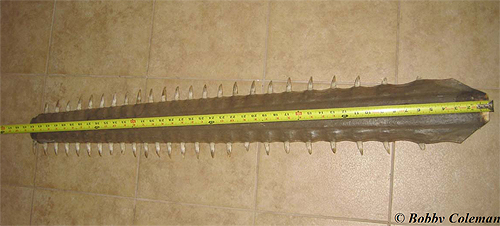Lesson: Sawfish Bycatch
Lesson Summary:
During this activity, students will learn about how easily endangered sawfish get captured as bycatch in net fisheries that target other non-endangered aquatic species.
Vocabulary:
Bycatch, fisheries, endangered, vulnerable, rostrum, rostral teeth
Background Information:
The principal threat to all sawfishes is fisheries, both targeted and bycatch, commercial and subsistence. Bycatch describes living creatures that are caught unintentionally by fishing gear. Unlike target species—animals specifically targeted for capture—bycatch is unwanted and often unused. Their morphology, particularly the long tooth-studded saw, makes them extraordinarily vulnerable to entanglement in any sort of net gear. The decline in smalltooth sawfish abundance has been caused primarily by bycatch in various fisheries, especially in gill nets. Because adults can grow very large and potentially damage fishing gear or even pose a threat to fishermen, many incidentally captured sawfish were killed before they were removed from fishing gear, even if the fishermen had no interest in keeping them.
Sawfish are listed as endangered under the Endangered Species Act, which makes it illegal to harm, harass, hook, or net sawfish in any way, except with a permit or in a permitted fishery. However, accidental captures do occur while fishing for other species. For your safety and the safety of the sawfish, use caution if you do hook or net a sawfish. They are large powerful animals that can cause serious injury. See the “Sawfish Encounters” handout advice for the safe release of sawfish.
Materials:
Teacher’s activity guide
Photos of sawfish rostrums (saws) including rostrum measurements
Poster board
Construction paper
Crayons, colored markers, or colored pencils
Tape or glue
Netting
Procedure:
Students will be taught about the sawfish rostrum and how this anatomical feature makes the sawfish more vulnerable to being captured as bycatch in net-based fisheries. Students will form groups or work together as a class to construct a replica of a sawfish rostrum with poster board and/or construction paper. Be sure the students use the real life measurements of the smalltooth sawfish rostrum provided with this teaching activity. They will also be responsible for attaching each rostral tooth. Upon completion of sawfish rostrum construction, have some students hold up the net as it might be moving through the water. At the same time, have a small group of students move the rostrum as the sawfish might swim in the same area as the net. They should think about how the water is sometimes murky, making the net difficult for the sawfish to see. The students can close their eyes, and “swim” the rostrum into the netting.

The rostral saw or rostrum of the smalltooth sawfish measures approximately 25% of the body’s total length – the rostrum measures about 44”, how large was the sawfish this was removed from, total length? Smalltooth sawfish have 25-32 pairs of rostral teeth.
Discussion Questions:
What happens when the rostrum makes contact with the netting?
Do the teeth get easily entangled?
How might this affect populations of endangered sawfish residing in areas where net fisheries are located?
What can be done to reduce or avoid catching sawfish as bycatch?
What should someone do if they accidentally capture a sawfish? (refer to “Sawfish Encounters” handout)
Extension Activities:
Follow up this activity with students making posters to raise awareness about the problem of bycatch and what people should do if they accidentally capture a sawfish in fishing gear or nets.